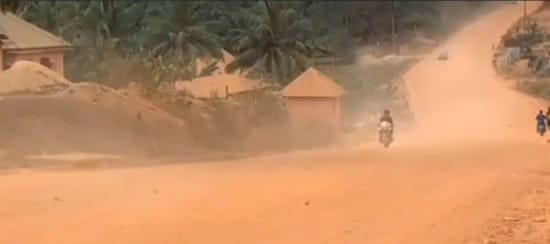The communities of Manso Mem and Domi in the Amansie South District of Ghana’s Ashanti Region are grappling with a severe infrastructural crisis centered around their dilapidated road network and an inadequate power supply. The deplorable condition of the roads has created a dual hardship, transforming into dust bowls during the dry season and treacherous quagmires during the rainy season. This cyclical deterioration poses a significant threat to the health and well-being of residents, particularly vulnerable groups such as pregnant women, children, and the elderly. The resulting isolation also severely restricts access to essential services, including healthcare, markets, and educational facilities, further exacerbating the challenges faced by these communities.
The dry season brings its own set of health hazards, as the unpaved roads disintegrate into a fine dust that permeates the air. This constant exposure to airborne dust particles contributes to a high incidence of respiratory illnesses, including asthma, persistent coughs, and other lung-related ailments. Children are especially susceptible to these respiratory problems, and the prevalence of such conditions adds another layer of burden to an already strained healthcare system. The inability to easily access healthcare facilities due to the impassable roads further complicates treatment and disease management, creating a vicious cycle of poor health outcomes.
When the rains arrive, the roads transform into muddy, impassable tracks, effectively cutting off Manso Mem and Domi from the outside world. This seasonal isolation poses a critical risk to residents requiring urgent medical attention, particularly pregnant women in labor. The difficulty in reaching healthcare facilities can lead to complications during childbirth and even maternal mortality. The elderly, also vulnerable due to age-related health issues, face similar challenges accessing timely medical care. This precarious situation underscores the urgent need for improved road infrastructure to ensure safe and reliable access to healthcare services for all residents.
The lack of adequate infrastructure has not only impacted the health and well-being of the communities but has also significantly disrupted their economic activities. The impassable roads during the rainy season prevent farmers from transporting their produce to markets, resulting in significant economic losses and contributing to food insecurity. The lack of access to markets also limits the availability of essential goods and services, further isolating the communities and hindering their economic development. This cyclical pattern of infrastructural deficiency and economic hardship emphasizes the need for sustainable solutions to improve the livelihoods of the residents.
Adding to the plight of the residents is the unreliable electricity supply, a problem attributed to an overloaded transformer serving the area. The frequent power outages have resulted in the damage of household appliances, adding an additional financial burden to the already struggling communities. The inconsistent power supply also disrupts businesses and hampers educational opportunities, further hindering the progress and development of Manso Mem and Domi. This critical infrastructure gap highlights the urgent need for investment in a more robust and reliable power grid to support the needs of the growing population.
The residents of Manso Mem and Domi, through their Assembly Member, Hon. James Osei, have made repeated appeals to the District Assembly and relevant authorities, highlighting the dire situation and urging immediate intervention. Despite numerous petitions and pleas, their calls for help have gone unanswered, leaving the communities feeling neglected and abandoned. Hon. Osei emphasizes the urgency of the situation, pleading with the government to treat the infrastructure crisis as an emergency. The lack of response from authorities underscores the need for greater accountability and responsiveness to the needs of marginalized communities, especially in the face of such critical infrastructure challenges that directly impact the health, well-being, and livelihoods of the residents.


